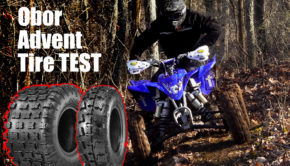Published on December 4th, 2023 | by Joe
2024 Kayo Jackal 200 Test Review
2024 Kayo Jackal 200 Test Ratings
Summary: Its easily managed engine and stable handling will make learning easy for beginners with enough performance that experienced riders can have fun ripping around on the Jackal. Kayo is delivering a higher level of build quality and refinement than you might expect. While very affordable, $3,699 isn’t exactly the price for a disposable toy, and the Kayo certainly seems far better than that.
3 Ride Test
The US market is in serious need of an entry to intermediate level sport ATV to replace the Honda 300EX and Raptor 250; not something with an automatic CVT, single lever brakes, or performance limiting shaft drive. We need a proper sport ATV with separate front and rear brakes, a manual shift gearbox, and chain drive to maximize performance.
Dirt Wheels Magazine turned us on to the Kayo Jackal 200 a while back. A proper little sport ATV, they praised its performance and overall construction. We, since, came across videos of Kayo’s A300 sport ATV that they sell overseas. It appears to be a little larger than the Jackal 200 in every way. Powered by a four-valve, double-overhead-cam fuel injected, four-stroke engine, claimed horsepower varies from the low to mid 30s, more than the old Honda 400EX and Suzuki Z400. The A300 appears as though it could fill our need for a new 250 to 300cc sport ATV if they’d import it.
Our A300 discovery and Dirt Wheels review of the Kayo Jackal 200 got us excited about the brand’s potential and just how fun the little Jackal 200 might be. So, for all of us interested in discovering the next big thing in little sport ATVs, we present to you ATV on Demand’s test of the Kayo Jackal 200.
ATV on Demand’s test of the Kayo Jackal 200 is made possible by
Trim Packages
The Kayo Jackal 200 is available in a single trim package. Retailing for $3,699, it’s $1,700 less expensive than its closest competitor the $5,399, shaft-driven Honda TRX250X. There are also a few CVT equipped machines out there in the 200-250cc range with removable speed restrictions to meet the requirement for riders 14 and up. But again, we’re all about banging gears, and the Kayo is the only one of the bunch that doesn’t compromise on the features that make a true sport ATV
Engine Performance
The Jackal 200 is powered by a 199cc, air cooled, four-stroke engine with a remote oil cooler. The top-end has a basic two-valve SOHC head design with bore and stroke of 65.5mm x 59mm and a safe, conservative compression ratio of 9.25:1. We ran premium pump gas for testing, but you can run as low as 87 octane. A carburetor feeds air and fuel to the engine. The sizable airbox and dirt bike style filter allow easy air filter maintenance with no tools.
The top-end is mated to a manual clutch equipped four-speed manual shift transmission with reverse. You shift up for 1st through 4th gears and down from neutral to shift into reverse. Fortunately, the transmission won’t allow you to shift down into reverse from neutral if the machine is rolling.
Choke the carb, pull in the clutch, and push the starter button; the Jackal fires up pretty quickly. The electric starter doesn’t have a kick starter or recoil backup. We noticed a small drain taking place on the battery if we left it sitting for a few weeks; so, hook up a battery tender for storage.
The Jackal takes a couple of minutes to fully warm up. Once the choke is off, the engine runs pretty smoothly. Throttle response is good with no sputtering or popping. The engine emits a quiet four-stroke sound that shouldn’t offend close-by neighbors with the occasional casual backyard romp.
Low-end power is pretty good, making getting rolling easy for those new to a manual clutch. There’s plenty of smooth, controllable low-end power for tooling around on the flats. For spirited rides or times that the trail turns upwards, you’ll be spending most of your time in the midrange and upper RPMs. There’s a smooth usable surge of power that comes on in the upper midrange with decent top-end and over-rev for a little, two-valve thumper. Requiring you to run the engine in the upper RPMs to get the most out of it makes you want to ride it more aggressively, maintaining the fun factor with the little engine as riders’ skills grow.
Mandatory for fun, there’s enough power to get the Jackal a little sideways out of turns if traction is low or you get aggressive. First gear wheelies are obtainable with enough snap in the lower gears to lighten the front-end for crossing obstacles or carrying the front end on a drop. You won’t be clearing any massive gaps on the track, but there’s enough power on tap to get the 200 airborne.
First gear is ideal for take-offs and low speed technical sections. First through third gears are well spaced. Beginners can upshift at lower RPMs without the engine falling on its face thanks to good low-end power. With no fifth gear, the gap between 3rd and 4th is pretty big. You have to rev 3rd gear pretty far out to pull 4th gear with any authority. We spent a lot of time at high RPMs in 3rd wishing for a smaller gap to 4th gear. The Jackal would be better off trading its reverse gear for 5 forward gears with closer ratios between 3rd, 4th and 5th. Fortunately, the engine has a broad powerband, which allows it to work pretty well with the four-speed. Gear ratios in reverse are a little high for backing up an incline.
Clutch pull is light. It was smooth on takeoff and slipping the clutch was effective at coaxing more speed out of the Kayo exiting turns. Shifting is pretty smooth with very few miss-shifts throughout our testing.
In spite of its limited size, the little 199cc engine was able to provide some fun on the trail for a 195 pound test rider. The lighter the rider ,the more fun the 200 will be.
Suspension and Handling
The Jackal 200 is built on a respectable looking tubular steel chassis with a non-removable subframe. Weld quality is somewhere in the middle and far better than what we’ve seen on those $1,000, no name, disposable machines. The frame and subframe are gusseted in the higher stress areas, appearing to be built for real off-roading. The lower front frame rails and A-Arm mounts are closely spaced, which should help minimize bump steer.
Dual A-Arm suspension is used up front with a swingarm and solid axle used out back. The swingarm looks well designed with an easy to use round-housing chain adjustment system held in place by dual pinch bolts on either side of the swingarm.
The shocks are pretty basic with 5-way preload adjustment up front. The linkageless rear suspension is controlled by a single shock with threaded spring preload adjustment. Kayo is not listing suspension travel. We’d estimate it to be around 5” at both ends, but don’t hold us to it.
The 200 rolls on 20×7-10” tires front and 19×10-10” tires rear mounted on steel wheels. The tires have a relatively narrow footprint in the middle for acceleration and braking grip with little tread on the sides making them easier to slide.
The Kayo is claimed at 43.5” in width with a 42.9” wheelbase, a 31.4” seat height, 42” overall height, and 3.7” of ground clearance under the axle carrier. It’s a bit wider, lower, and shorter than the Honda 250X. It’s a tad heavy for a chain driven, manual shift, entry level sport ATV at 363.7 pounds compared to the long since departed 313 pound Raptor 250. Hopefully, that means it’s tough.
Like the engine, the suspension works best when pushed a little. It’s necessarily on the firm side to prevent blowing through its travel on bigger hits. The shocks take the edge off smaller bumps from roots and rocks, but as we said, it’s a bit firm, magnified by the smaller tires. The shocks work better on medium size hits with the rear shock seemingly a little more active than the fronts. Landing from a couple feet of air, the shocks do well. We only felt the front’s bottom once or twice throughout our testing.
Firmer shock settings and a lower CG feeling for its width make the Jackal 200 feel pretty planted in the turns. We felt good braking late, dropping a gear, stuffing it hard into turns, and ripping out of corners at a high RPM a little sideways. It also feels equally stable on sidehills. On steep, punchy climbs, the Kayo felt predictable with good body English. The shorter wheelbase had us letting off the brakes on short, punchy descents. The smaller tires, which aid acceleration and handling do require more careful line selection in the chunky stuff as they limit ground clearance.
Steering on our unit was a little on the stiff side for smaller riders. We loosened the stem clamp, lubed and reassembled it, and it made no noticeable difference. The Kayo did well at going where it was pointed; we only wish the handlebars turned a little farther to maximize the tight turning radius its short stable footprint can provide.
Overall, handling and suspension are good enough to utilize all of the performance the sporty little 200 engine provides. This makes learning ATV handling easier for beginners and more fun regardless of skill level.
Brakes
Braking performance is excellent. Dual hydraulic disc brakes front and a single hydraulic disc out back slow the Kayo. Braking power and feel are both on par with what we would expect from a major OEM. The rear end could be kept hooked up or broken loose on demand to initiate a slide. The front brakes had enough power to quickly scrub off speed entering turns, and the separate front and rear brakes allow the rider to modulate the braking bias to maximize braking power and traction. Good brakes can’t be overlooked on a Sport ATV and the Jackal’s worked great.
Fit and Finish
For an age 16 and up machine, the Jackal 200’s ergonomics are a little on the small side. The machine will best fit riders in the 5’ to 5.’8” range, but it still left room for a 6.0’ tall rider to move around. The Jackal is narrow between your legs with a flat seat that’s easy to move around on although it is a little firm. Its low height aids the machine’s stable cornering manners. The handlebar bend and height should accommodate different size riders pretty well. Levers and switches don’t feel super refined; however, they don’t feel like they’re going to immediately break or fail. The steel footpegs are accompanied by plastic heel guards, and it’s nice to see a set of nerf bars included standard.
We’re not going to complain about halogen headlights on an ATV at this price point. The headlights and combination tail and brake light out back offer enough candle power for some fun in the dark.
While the chassis seems well built and the overall design seems pretty well thought out and executed. We did find many of the body fasteners to be way overtightened. Bolts and screws throughout the machine lacked lubrication or Loctite and thread tolerances are on the tight side. The machine’s build seems pretty good, but the finishing touches could be cleaned up a little.
Conclusion
Waiting until now to pull back the curtain for those not aware, Kayo is a Chinese manufacturer. Based on our personal experience thus far and the feedback we’ve received from owners, dealers, and our friends at Dirt Wheels, Kayo is delivering a higher level of build quality and refinement than you might expect. While very affordable, $3,699 isn’t exactly the price for a disposable toy, and the Kayo certainly seems far better than that.
While not quite the replacement for the 300EX or Raptor 250 many are dreaming of, its easily managed engine and stable handling will make learning easy for beginners with enough performance that experienced riders can have fun ripping around on the Jackal. The biggest thing missing, at this point, is the availability of aftermarket parts to hop it up! Hopefully, the aftermarket will get on board.
We think it’s safe to say that the Kayo Jackal 200 is the best sport ATV on the market at or below 200cc. Based on our experience, we hope the Jackal 200 is a step toward bigger sport ATVs to come from Kayo! The entry level sport quad market is theirs for the taking.










